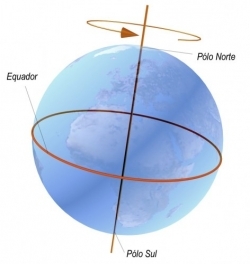land axis is imaginary line through the center of the Earth, going from the North Pole to the South Pole. The Earth moves around the imaginary axis, taking a total of 24 hours to complete the turn. So these twenty four hours of movement result in a day and a night.
The Earth's axis is a straight line, which is slightly inclined in relation to the Sun, always pointing in the direction of the Polar Star.
As the earth rotates on itself, around its axis, it travels through space, perpendicularly, around the sun, traveling in a slightly oval orbit, in the shape of an ellipse. This movement is called translation and it takes 365 days and 6 hours to complete one Earth revolution.

The tilt of the earth's axis is very important. Without it, all points on earth would receive the same amount of light and solar heat throughout the year. Because of the tilt of the axis, as the earth travels through its orbit, the regions that receive more light and heat change.
This perpendicular movement around the sun is called the Earth's translation movement. The seasons of the year depend on it: summer, autumn, winter and spring.
After some earthquakes, such as those in Chile in 2010 and Japan in 2011, experts believed that the phenomenon altered the Earth's axis about eight centimeters, making the days become more short. However, one theory states that the terrestrial axis did not undergo changes in its orientation in relation to the sun and stars, the change was only in relation to the earth's crust.
